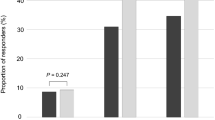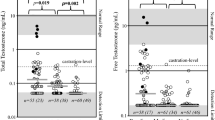Abstract
Radical prostatectomy is one of the treatment of choices for localized prostate cancer. Published data show that radical prostatectomy is associated with both an increase and decrease in testosterone levels. This study aimed to document the changes in pre- and postoperative serum testosterone levels after radical prostatectomy along with the associations between serum testosterone levels and prostate cancer profiles in Thai population. Localized and locally advanced prostate cancer patients who elected to have radical prostatectomy without prior androgen deprivation therapy were included in the study. Patients’ demographic data, pre- and postoperative serum testosterone levels, sex hormone binding globulin, albumin, prostate-specific antigen, and final pathologic reports were collected. Eighty-five prostate cancer patients were included in this study. Mean age was 67.32 years. Mean pre- and postoperative serum testosterone levels were 424.95 ng/dL and 371.94 ng/dL, respectively (p-value < 0.001). There was a greater testosterone reduction in patients with a final pathologic report of Gleason 4 + 3 and above compared with those with a Gleason 3 + 3 and 3 + 4 (p-value = 0.001). No significant association between preoperative testosterone levels and final Gleason scores was observed. This study documented significant postoperative testosterone reductions in prostate cancer patients after a radical prostatectomy. Patients with high Gleason grades had greater testosterone reductions. These findings may have clinical implications for the prediction of postoperative hypogonadal states in prostate cancer patients.
This is a preview of subscription content, access via your institution
Access options
Subscribe to this journal
Receive 8 print issues and online access
$259.00 per year
only $32.38 per issue
Buy this article
- Purchase on Springer Link
- Instant access to full article PDF
Prices may be subject to local taxes which are calculated during checkout
Similar content being viewed by others
References
Huggins C, Hodges CV, Studies on Prostatic Cancer. I. The effect of castration, of estrogen and of androgen injection on serum phosphatases in metastatic carcinoma of the prostate. Cancer Res. 1941;1:293–7.
Khera M, Crawford D, Morales A, Salonia A, Morgentaler A. A new era of testosterone and prostate cancer: from physiology to clinical implications. Eur Urol. 2014;65:115–23.
Michaud JE, Billups KL, Partin AW. Testosterone and prostate cancer: an evidence-based review of pathogenesis and oncologic risk. Ther Adv Urol. 2015;7:378–87.
Madersbacher S, Schatzl G, Bieglmayer C, Reiter WJ, Gassner C, Berger P, et al. Impact of radical prostatectomy and TURP on the hypothalamic-pituitary-gonadal hormone axis. Urology. 2002;60:869–74.
Miller LR, Partin AW, Chan DW, Bruzek DJ, Dobs AS, Epstein JI, et al. Influence of radical prostatectomy on serum hormone levels. J Urol. 1998;160:449–53.
Gacci M, Tosi N, Vittori G, Minervini A, Corona G, Cai T, et al. Changes in sex hormone levels after radical prostatectomy: results of a longitudinal cohort study. Oncol Lett. 2013;6:529–33.
Carroll PR, Parsons JK, Andriole G, Bahnson RR, Barocas DA, Castle EP, et al. NCCN Clinical Practice Guidelines Prostate Cancer Early Detection, Version 2.2015. J Natl Compr Canc Netw. 2015;13:1534–61.
Loeb S, Folkvaljon Y, Robinson D, Lissbrant IF, Egevad L, Stattin P. Evaluation of the 2015 Gleason Grade Groups in a Nationwide Population-based Cohort. Eur Urol. 2016;69:1135–41.
Dandona P, Rosenberg MT. A practical guide to male hypogonadism in the primary care setting. Int J Clin Pract. 2010;64:682–96.
Wang C, Nieschlag E, Swerdloff RS, Behre H, Hellstrom WJ, Gooren LJ, et al. ISA, ISSAM, EAU, EAA and ASA recommendations: investigation, treatment and monitoring of late-onset hypogonadism in males. Aging Male. 2009;12:5–12.
Mulhall JP, Trost LW, Brannigan RE, Kurtz EG, Redmon JB, Chiles KA, et al. Evaluation and management of testosterone deficiency: AUA guideline. J Urol. 2018;200:423–32.
Mulligan T, Frick MF, Zuraw QC, Stemhagen A, McWhirter C. Prevalence of hypogonadism in males aged at least 45 years: the HIM study. Int J Clin Pract. 2006;60:762–9.
Salonia A, Gallina A, Briganti A, Abdollah F, Suardi N, Capitanio U, et al. Preoperative hypogonadism is not an independent predictor of high-risk disease in patients undergoing radical prostatectomy. Cancer . 2011;117:3953–62.
Yamamoto S, Yonese J, Kawakami S, Ohkubo Y, Tatokoro M, Komai Y, et al. Preoperative serum testosterone level as an independent predictor of treatment failure following radical prostatectomy. Eur Urol. 2007;52:696–701.
Hammarsten J, Damber JE, Peeker R, Mellstrom D, Hogstedt B. A higher prediagnostic insulin level is a prospective risk factor for incident prostate cancer. Cancer Epidemiol. 2010;34:574–9.
Hammarsten J, Hogstedt B. Clinical, haemodynamic, anthropometric, metabolic and insulin profile of men with high-stage and high-grade clinical prostate cancer. Blood Press. 2004;13:47–55.
Carstensen H, Amer B, Amer I, Wide L. The postoperative decrease of plasma testosterone in man, after major surgery, in relation to plasma FSH and LH. J Steroid Biochem. 1973;4:45–55.
Reyes JG, Farias JG, Henriquez-Olavarrieta S, Madrid E, Parraga M, Zepeda AB, et al. The hypoxic testicle: physiology and pathophysiology. Oxid Med Cell Longev. 2012;2012:929285.
Zhang PL, Rosen S, Veeramachaneni R, Kao J, DeWolf WC, Bubley G. Association between prostate cancer and serum testosterone levels. Prostate. 2002;53:179–82.
Nishiyama T, Ikarashi T, Hashimoto Y, Suzuki K, Takahashi K. Association between the dihydrotestosterone level in the prostate and prostate cancer aggressiveness using the Gleason score. J Urol. 2006;176(4 Pt 1):1387–91.
Dai B, Qu Y, Kong Y, Ye D, Yao X, Zhang S, et al. Low pretreatment serum total testosterone is associated with a high incidence of Gleason score 8-10 disease in prostatectomy specimens: data from ethnic Chinese patients with localized prostate cancer. BJU Int. 2012;110(11 Pt B):E667–72.
Hoffman MA, DeWolf WC, Morgentaler A. Is low serum free testosterone a marker for high grade prostate cancer? J Urol. 2000;163:824–7.
Botto H, Neuzillet Y, Lebret T, Camparo P, Molinie V, Raynaud JP. High incidence of predominant Gleason pattern 4 localized prostate cancer is associated with low serum testosterone. J Urol. 2011;186:1400–5.
Lane BR, Stephenson AJ, Magi-Galluzzi C, Lakin MM, Klein EA. Low testosterone and risk of biochemical recurrence and poorly differentiated prostate cancer at radical prostatectomy. Urology. 2008;72:1240–5.
Massengill JC, Sun L, Moul JW, Wu H, McLeod DG, Amling C, et al. Pretreatment total testosterone level predicts pathological stage in patients with localized prostate cancer treated with radical prostatectomy. J Urol. 2003;169:1670–5.
Imamoto T, Suzuki H, Fukasawa S, Shimbo M, Inahara M, Komiya A, et al. Pretreatment serum testosterone level as a predictive factor of pathological stage in localized prostate cancer patients treated with radical prostatectomy. Eur Urol. 2005;47:308–12.
Teloken C, Da Ros CT, Caraver F, Weber FA, Cavalheiro AP, Graziottin TM. Low serum testosterone levels are associated with positive surgical margins in radical retropubic prostatectomy: hypogonadism represents bad prognosis in prostate cancer. J Urol. 2005;174:2178–80.
Locke JA, Guns ES, Lubik AA, Adomat HH, Hendy SC, Wood CA, et al. Androgen levels increase by intratumoral de novo steroidogenesis during progression of castration-resistant prostate cancer. Cancer Res. 2008;68:6407–15.
Brambilla DJ, Matsumoto AM, Araujo AB, McKinlay JB. The effect of diurnal variation on clinical measurement of serum testosterone and other sex hormone levels in men. J Clin Endocrinol Metab. 2009;94:907–13.
Acknowledgements
We would like to thank Mr. Nattawut Unwanatham (Department of Clinical Epidemiology and Biostatistics, Ramathibodi Hospital) and Mrs. Kaewjai Tepsuthumarat (Research Affairs, Faculty of Medicine, Khonkaen University) for their contribution to the statistical analysis.
Funding
This study was supported by Ramathibodi Hospital, Mahidol University.
Author information
Authors and Affiliations
Corresponding author
Ethics declarations
Conflict of interest
The authors declare that they have no conflict of interest.
Additional information
Publisher’s note: Springer Nature remains neutral with regard to jurisdictional claims in published maps and institutional affiliations.
Rights and permissions
About this article
Cite this article
Lumbiganon, S., Patcharatrakul, S., Khongcharoensombat, W. et al. Pre- and post-radical prostatectomy testosterone levels in prostate cancer patients. Int J Impot Res 31, 145–149 (2019). https://doi.org/10.1038/s41443-019-0116-0
Received:
Revised:
Accepted:
Published:
Issue Date:
DOI: https://doi.org/10.1038/s41443-019-0116-0



